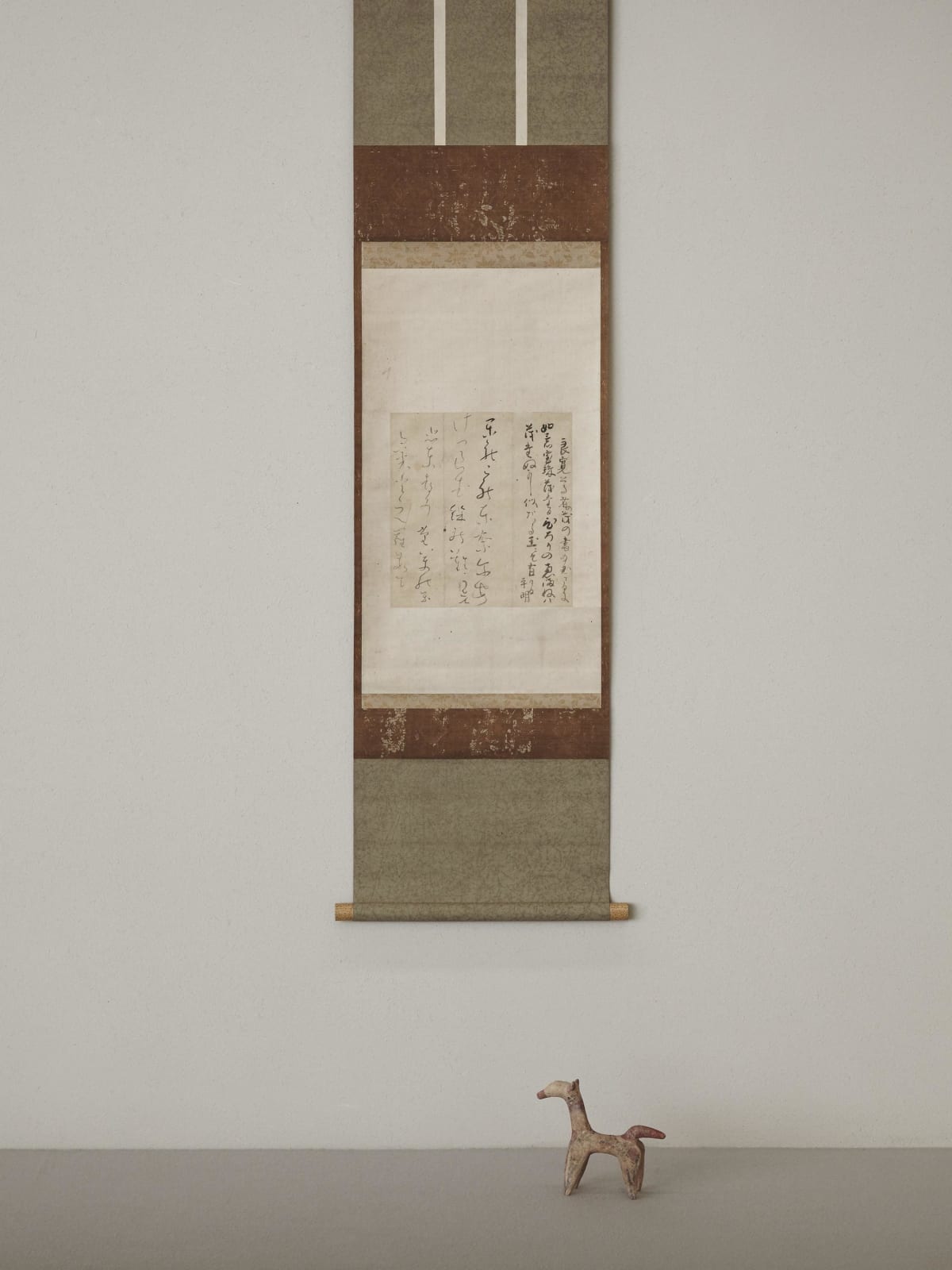Ryōkan (1758–1831)
Waka Dialogue
Ink on paper, hanging scroll
With box authentication and titled by Soma Gyofu, double boxed
24.5 x 23 cm
135 x 32 cm (overall)
With box authentication and titled by Soma Gyofu, double boxed
24.5 x 23 cm
135 x 32 cm (overall)
Further images
Exhibitions
Dai ni kai Ryokan osho ibokuten. Tokyo: Man’yodo, 1971.Ryokan no sho. Tsuruoka: Chido Museum, 1975.
Literature
Ryokan osho ibokushu. Tokyo: Shunyodo, 1919.Ryokan. Tokyo: Chikumashobo, 1960.
Ryokan ibokuko. Tokyo: Kyuryudo, 1974.
Ryokan bokuseki taikan vol. 3. Tokyo: Chuo-koron Bijutsu Shuppan, 1993.
Heimei from Izumozaki sent a waka to Ryokan, who hardly composed calligraphy at request. Heimei intentionally left half of the paper blank, in the hope that Ryokan would reply on the same paper. Ryokan responded to Heimei’s writing with a waka on the same paper, which comprises the present work. Ryokan’s calligraphy, favored by a great many, has been admired ever since his own day. It is said that many had attempted to attain his writings in one way or another.
Titled “Since honorable Ryokan would not write [for me],” Heimei’s waka reads: “A venerable man as you who possess the sacred gem of talent refrains from writing a piece of calligraphy for others: isn’t it the same as you don’t own the sacred gem?” Ryokan responds: “What are you talking about? Don’t you know that every creation in this world is looked after by the souls of our predecessors?” Ryokan’s playful interpretation of “the sacred gem” as “the soul” is particularly intriguing here.
Ryokan was a great admirer of jodaiyo, the graceful ancient caluligraphy style. He borrowed the style in his own writing, which performs at its best in the flowing grass script (sogana) exemplified in the present work. Incorporating Ryokan’s relaxed writing with his edifying waka, this work enchantingly speaks of Ryokan’s personality.
Ryokan (Zen priest, poet; 1758–1831)
Echigo-born late Edo-period Zen priest and poet. Became a disciple of Genjo at Kosho-ji temple, and was given the Buddhist name “Taigu Ryokan.” Also studied under Kokusen at Entsu-ji temple in Tamashima, Bicchu. Later traveled to numerous provinces in over twenty years, and led a free life that is full of anecdotes about his eccentric behaviors. His waka (Japanese-style poetry) composition in the style of Man’yoshu and his calligraphy manner are so well balanced that it is highly praised.
Titled “Since honorable Ryokan would not write [for me],” Heimei’s waka reads: “A venerable man as you who possess the sacred gem of talent refrains from writing a piece of calligraphy for others: isn’t it the same as you don’t own the sacred gem?” Ryokan responds: “What are you talking about? Don’t you know that every creation in this world is looked after by the souls of our predecessors?” Ryokan’s playful interpretation of “the sacred gem” as “the soul” is particularly intriguing here.
Ryokan was a great admirer of jodaiyo, the graceful ancient caluligraphy style. He borrowed the style in his own writing, which performs at its best in the flowing grass script (sogana) exemplified in the present work. Incorporating Ryokan’s relaxed writing with his edifying waka, this work enchantingly speaks of Ryokan’s personality.
Ryokan (Zen priest, poet; 1758–1831)
Echigo-born late Edo-period Zen priest and poet. Became a disciple of Genjo at Kosho-ji temple, and was given the Buddhist name “Taigu Ryokan.” Also studied under Kokusen at Entsu-ji temple in Tamashima, Bicchu. Later traveled to numerous provinces in over twenty years, and led a free life that is full of anecdotes about his eccentric behaviors. His waka (Japanese-style poetry) composition in the style of Man’yoshu and his calligraphy manner are so well balanced that it is highly praised.







